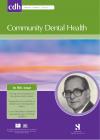Community Dental Health

- Cover Date:
- June 2011
- Print ISSN:
- 0265 539X
- Vol:
- 28
- Issue:
- 2
The Relationship between Self-Reported Oral Health, Self-Regulation, Proactive Coping, Procrastination and Proactive Attitude
Objectives: This cross-sectional study investigated the relationship between self-regulation, proactive coping, procrastination and proactive attitude, perceived oral health and self-reported oral-health behaviours. Methods: The study sample consisted of 198 first year medical students. The questionnaire included information about socio-demographic factors, behavioural variables, self-reported oral health status, proactive coping (proactive coping subscale of the Proactive Coping Inventory), procrastination (Procrastination Scale) and proactive attitude (Proactive Attitude Scale). Results: Significant differences were found on self-regulation, proactive coping, procrastination and proactive attitude scales between participants who rated their gingival condition as very good/excellent and those who evaluated it as being poor, very poor or normal (p<0.05). Results revealed significant differences in procrastination level among individuals who never visit their dentist and those who visit their dentist for check-up or for tooth cleaning and scaling (p=0.001) or when treatment is needed or when in pain (p<0.05). In multiple linear regression analyses, proactive coping was associated with toothbrushing frequency and reason for dental visiting. Conclusions: The result suggested that procrastination and proactive coping are important determinants of perceived oral health and self-reported oral-health behaviours.
Key words: self-regulation, proactive coping, procrastination, proactive attitude, oral health, oral health behaviours
- Article Price
- £15.00
- Institution Article Price
- £
- Page Start
- 170
- Page End
- 173
- Authors
- A.L. Dumitrescu, B.C. Dogaru, C.D. Dogaru, B. Manolescu
Articles from this issue
- Title
- Pg. Start
- Pg. End
- Socioeconomic inequality in self-reported oral health status: The experience of Thailand after implementation of the Universal Coverage policy
- 136
- 142
- Relationship between dental anxiety, general anxiety level and depression in patients attending a university hospital dental clinic in Turkey.
- 149
- 153
- Relationship between bone fragility of the mandibular inferior cortex and tooth loss related to periodontal disease in older people
- 165
- 169
- The Relationship between Self-Reported Oral Health, Self-Regulation, Proactive Coping, Procrastination and Proactive Attitude
- 170
- 173
- Is there a correlation between dental caries and body mass index-for-age among adolescents in Iran?
- 174
- 177
- Nigerian dentists’ knowledge of the current guidelines for preventing infective endocarditis
- 178
- 181
